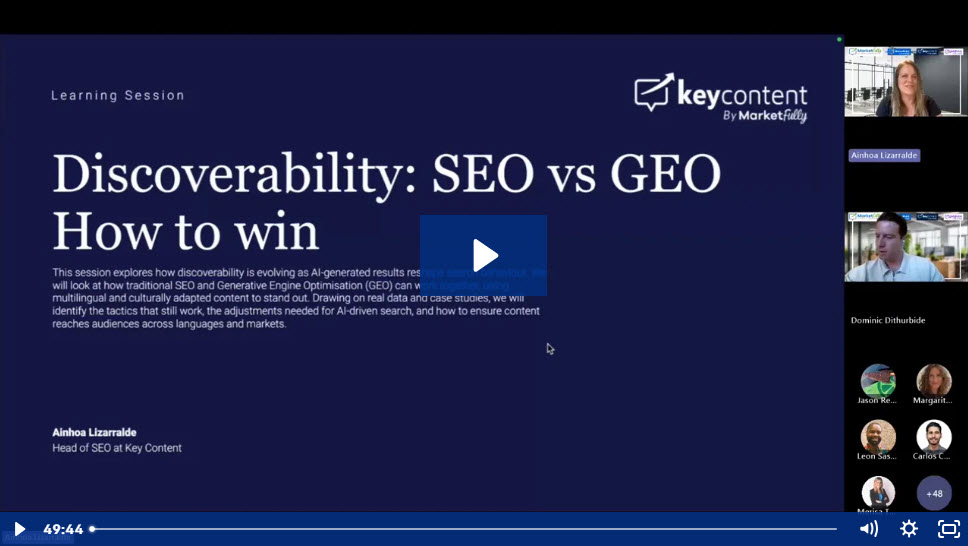English still dominates the landscape in the world of internet languages, with roughly half of the top websites, while Chinese, Spanish, Russian, Persian, French, German and Japanese fill out the rest of the major slots. The web is made up of more than these seven tongues, though, with over 7,000 living languages in the world, and only a few hundred with any kind of presence online. The distribution is shifting.
Recent data shows that English has dipped from about 55% to 49.1% of content on top websites from 2023 to 2025, while Spanish, German, Japanese, and Portuguese all gained ground. This language distribution online makes clear that even as English stays the course, other languages are growing faster.
W3Techs reports that Spanish rose to 6.0% and German rose to 5.8% of web content by early 2025. To put it simply, almost every day, millions of speakers of Vietnamese, Arabic, Indonesian, and dozens of other languages are looking for reliable online content.
AI Overview is setting the stage
Here’s where AI Overviews start to come in. AI Overviews was launched in the U.S. in 2024 and has since expanded “to more than 100 countries” with support for six languages (English, Hindi, Indonesian, Japanese, Portuguese and Spanish). Google’s new generative-answer feature gives us succinct summaries of complex queries right on the search results page. AI Overviews now acts as a global stage that connects quality content to speakers around the world in their own tongue.
Unlike a flat list of links, AI Overviews can draw from multiple sites in one summary. Google explains that these overviews “help people get to the gist of a complicated topic or question more quickly, and provide a jumping off point to learn more”*. The box will still cite original sources and even embed site icons or in-text links to the supporting pages, giving publishers clear credit.
Google’s trials found that the redesigned AI Overviews (with right-hand link panels and inline links) increased traffic to referenced sites compared to earlier versions. This means that high-quality content can gain visibility without even ranking first in classic results, which is a massive shift in content discovery. AI Overviews tend to give searchers a concise, AI-generated summary of top sites. Publishers whose content is drawn into the Overview often see more clicks to their pages.
This is an incredible shift in the world of content consumption. Instead of scanning 10 blue links, a user reads a natural-language answer that’s been sourced from multiple sites. It’s a bit like having a local guide translate and explain a tour of the internet. As Google notes, people often prefer search engines with AI Overviews because they find answers more helpful, and they tend to click through to a diverse number of sites for deeper learning.
For multilingual visibility, the impact is double-edged. On one hand, content must still rank well traditionally to be included, and on the other, its voice can now carry further via AI insights and inclusion. AI-aware content strategy means creating bite-sized, authoritative answers that AI systems can pull into those overviews.

Human authorship and E-E-A-T to keep the connection
Even as AI becomes part of your everyday search, human-written content and native authorship matter more than ever. Google’s guidelines emphasise “people-first content” that has first-hand expertise and authenticity woven into the content. In other words, content should be created for humans rather than to work with the algorithms.
This works in conjunction with Google’s E-E-A-T framework (Experience, Expertise, Authoritativeness and Trustworthiness), which it uses to evaluate quality. For example, Google asks if a page shows “clear evidence of the expertise involved” or is written by an expert who “demonstrably knows the topic well”. It also flags low-value, mass-produced content.
A recent survey found that 65% of marketers believe human-authored articles are far superior in quality to AI-generated ones*. One expert quipped that AI-written copy is “still in the stone age” compared to a top writer’s output.
This is important for online language because local idioms and cultural nuance often elude, or are overlooked by, machines. As a native speaker, you understand the subtext of regional terms, jokes, and context because it comes naturally, which isn’t the case for AI.
An experienced local writer can tailor content to the audience’s expectations and local SEO signals, including using region-specific keywords, cultural references, and even measuring units, which global AI might mishandle. When Google expanded AI Overviews worldwide, it noted that users in any country can see Overviews in any supported language.
This puts native-language content as the premium, go-to strategy. If you write about Japanese manga, writing part of it in Japanese by a local subject matter expert (even on a UK site) will align with how AI Overviews match the language preferences. AI is an amplifier, and will add to the authenticity of your content as long as the source is authentic. Content built on solid EEAT foundations is best positioned to be used by AI and loved by readers.

AI and multilingual SEO strategies
For global marketers and content strategists, there’s a clear message to invest in a multilingual content strategy that marries technical SEO with local insight. It’s still important to use hreflang tags, host content on local domains or subfolders, and optimise for region-specific search engines and queries. But now you also have to consider how AI might ingest that content.
Here are some key practices:
- Create truly local content. Go beyond machine translation. Commission or translate copy by native speakers who can adapt various idioms, examples, and your brand voice. Focus on user intent.
- Create content for snippets and answers. Break content into clear, succinct sections with direct answers to likely questions. Google’s AI Overviews favour content that is well-structured with clear subheadings and bulleted lists that mirror how they extract information. Marketers should make sure each language version of a page stands on its own with localised headers and summaries.
- Leverage local expertise (native authorship). Where possible, use local creators who understand the market. Featuring author bios or quotes in a local language can improve the way authoritativeness is seen.
- Optimise core content and metadata for each language. Titles, meta descriptions, and headlines should be compelling and contextually accurate in every language. An AI-driven search might show your snippet directly in an Overview, so clarity is crucial.
- Monitor performance holistically. GSC now includes the data in the reports, but only third party tools allow us, for now, to see the keywords filtered by AI Overviews featured results (Semrush is one of these tools)
In practice, a tech company that’s targeting LATAM could build a mix of Spanish and Portuguese blogs written by local experts, and then optimise these for relevancy (local slang, measurements) so that when a user from São Paulo or Bogotá queries, Google’s AI can pick up that unique content while local SEO (citations, Google Business Profiles) makes sure the content is crawled and indexed properly.
Internet access is growing fastest in Asia and Africa, often via mobile connections, and in local languages, and tech giants are building translation features and language models to meet this need. Google’s approach is to let users choose their preferred language for Overviews, hinting that they see language choice as fundamental to user experience.
For SEO leaders in EMEA, LATAM, and APAC, this new wave is an opportunity to meet users in their home tongue.

Giving every language a chance
Underrepresented languages gaining some traction in the online space is one of the most important possibilities of AI search inclusion. Today, smaller languages and dialects struggle to get visibility, even a globally significant language like Bengali is barely on W3Techs’s radar.
The great thing is, AI doesn’t have to treat them the same way older algorithms did. If users can get their answers in Hindi or Indonesian, why not in languages like Bengali or Thai? Google’s expansion suggests a long-term plan to support more languages as technology improves.
There are already initiatives pointing this way. UNESCO’s multilingualism roadmap calls for bridging the digital language divide by promoting content in local languages. They say that a lack of online material in a specific language will restrict access to knowledge for entire communities.
AI-driven translation and summarisation tools are being developed to help, but many experts stress that producing quality local content is irreplaceable*. In some cases, well-created local content might even fuel AI systems, like if a website in an under-represented language has a clear, in-depth topic guide, an AI Overview could draw from it for a global audience.

A future of many tongues
Search engines are evolving toward an agentic, deep-research model where AI finds and synthesises information simultaneously. Google has hinted that its search could eventually answer spoken questions and compile answers across formats. Imagine asking your voice assistant about earthquake safety in Tagalog, and hearing a concise AI summary drawn from Tagalog, English and maybe other international sources.
For now, SEO and content leaders must adapt to the current reality by weaving a multilingual strategy that honours the poetic variety of language while staying fundamentally sound with technical SEO. You’ll need to use native authors to create content that is truly relevant. Language visibility is transforming as we populate our websites, and the architects of tomorrow’s SEO must involve global storytellers who can blend poetic words with strategy and local nuance to make sure AI produces answers in all the world’s languages.
FAQs
What are AI Overviews in search?
AI Overviews are Google’s new feature that gives you an AI-generated summary of information for complex queries at the top of search results. They draw on multiple authoritative sources and include links back to the original sites. Users can see Overviews in supported languages and still click through to source content, so AI Overviews can boost content visibility for high-quality pages.
How does AI Overviews affect multilingual content?
Since AI Overviews now roll out globally and support multiple languages, a wider audience will have access to content in various languages. For example, a user in Spain searching in Spanish will see Spanish-language Overviews, even if some content is originally English. This means well-created local-language content has a better chance of surfacing in the search. In practice, multilingual SEO should make sure that each language version of the content is fully optimised and easy for AI to analyse, so AI systems can include it in Overviews.
Why is native authorship important for SEO now?
Content written by a native speaker or local expert, otherwise known as native authorship, tends to be richer in cultural nuance and accuracy. Google’s guidelines stress “first-hand expertise and a depth of knowledge” for high-quality content. AI Overviews and other features rely on the quality signals in the content, so a locally written article is more likely to satisfy those signals. Moreover, search algorithms (with human raters) prefer content that clearly demonstrates expertise and trustworthiness, which often comes from authentic local voices.
What is EEAT, and why does it matter?
E-E-A-T stands for Experience, Expertise, Authoritativeness, and Trustworthiness. It’s a concept in Google’s Search Quality guidelines that helps Google evaluate content quality. Good EEAT means that content is written by knowledgeable authors (expertise), shows real-world experience, and is backed by reputable sources. Content that scores high on EEAT is more likely to rank well and be picked up in AI Overviews. For multilingual content, this means local experts should create or endorse the content to increase trust signals.
Can underrepresented languages benefit from AI search?
Potentially, yes. AI Overviews could amplify high-quality content in lesser-used languages if those languages are supported or connected via translation. As tech giants expand AI tools for global audiences, content in smaller languages may be more accessible. SEO best practice is to keep producing strong content in your target language, and as AI search evolves, it may start to include those sources. Initiatives like UNESCO’s push for multilingual content also encourage more online information in underrepresented languages.
How should I design my multilingual SEO for the future?
Focus on creating a clear multilingual content strategy, and make sure each language version has unique, native-written content and is properly indexed (via hreflang and sitemap).
Structure your content to answer user questions directly, since AI is looking for clear answers and well-marked sections. Build author credibility (bios, citations) for each market. Track the site performance via Google Search Console’s reports to see which languages and queries are triggering AI features. Most importantly, keep content focused on people, first by giving them useful, trustworthy information.






